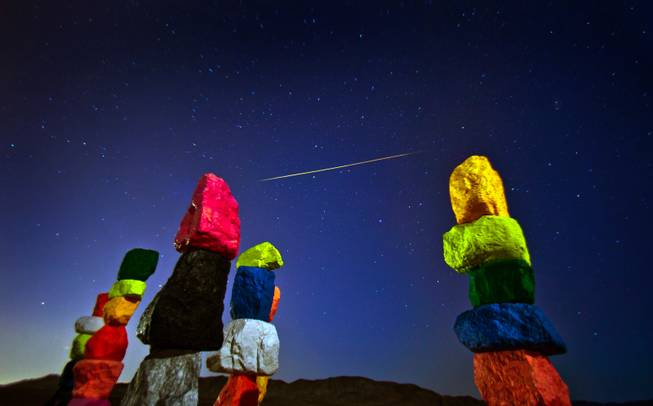
Courtesy
The Perseids meteor shower is seen from Ugo Rondinone’s Seven Magic Mountains art installation south of Las Vegas in 2016.
Friday, April 20, 2018 | 2 a.m.
Viewing tips
Remember that patience is key when you’re heading out to observe these celestial events. Double-check the weather, moonrise and sunrise reports, pack a blanket or chair for comfort, and don’t forget water and snacks. You never know how long you’ll be captivated by the night sky.
With so many brilliant lights to see in the city, it’s sometimes easy to forget the celestial bodies that shine in the vast desert sky.
With little condensation in desert climates, there are few clouds, leaving an uninterrupted dark expanse of night dotted with planets, stars, meteors and more. For a better view, take a road trip to the edge of town to one of the area’s parks, and keep one eye on the calendar to catch these upcoming astronomical events.
Resources
• In the Sky (in-the-sky.org): Discover what’s visible in tonight’s sky and where to see it from Las Vegas. Check out sky charts and visibility for objects like planets, comets, asteroids and more.
• Clear Dark Sky (cleardarksky.com): It’s not flashy, but it has tons of data. Search charts about sky conditions based on light pollution, weather and darkness for Las Vegas and surrounding areas.
• Las Vegas Astronomical Society (lvastronomy.com): This organization of amateur astronomers is devoted to promoting the “love and enjoyment of astronomy.” It operates under the auspices of the College of Southern Nevada Planetarium.
Recommended stargazing locations near Las Vegas
• Spring Mountain Ranch State Park
• Exploration Peak Park
• Mount Charleston Lodge
• Black Mountain
• Lake Meade Recreational Area
• Red Rock Canyon National Conservation Area
• Desert National Wildlife Refuge Visitor Center
May
• Aquarids meteor shower: While the moon will be in its waning gibbous phase, skygazers in darker areas will see up to 30 meteors per hour. Produced by Halley’s comet, this meteor shower runs April 19-May 28, but will peak May 6-7.
• Jupiter at opposition: Our solar system’s largest planet will be easy to spot in the southern sky in the constellation Libra. It will be almost directly opposite the sun. Peak brightness May 8-9.
June
• Saturn at opposition: The ringed planet will drop by to say hello toward the end of June. Fully illuminated and in direct opposition to the sun, look for it in the southern horizon. Peak height in the sky is midnight, June 27.
July
• Venus near the moon: In the southwestern sky, spot Venus near the waxing crescent moon. They will appear their closest July 15.
• Mars at opposition: Positioned its closest to Earth and in direct opposition to the sun, the red planet will be highly visible all night and into morning. Look for a bright orange “star” in the southern sky. Mars will be its biggest and brightest since July 2003 and won’t be this visible again until 2035. Peak visibility July 27.
August
• Perseids meteor shower: The Swift-Tuttle comet produces this annual intense meteor shower, throwing up to 60 meteors per hour at its peak. This year’s shower will be highly visible thanks to a thin crescent moon. Peak Aug. 12-13.
September
• Neptune at opposition: The giant, blue planet will be visible in the constellation Aquarius. However, because it’s the farthest planet from Earth in the solar system, it will still look like a tiny, blue dot. Peak brightness Sept. 7.
October
• Orionids meteor shower: You can thank leftover dust particles from Halley’s Comet for this annual show. The bad news? The moon will be almost full during its peak, so you’ll have to be in a dark space to see the fainter meteors. Peak, Oct. 21-22.
November
• Leonids meteor shower: Dust grains from the Tempel-Tuttle Comet make up this meteor shower. Not as “impressive” as others, the Leonids produce up to 15 meteors per hour. Wait for the waxing gibbous moon to set around midnight for your darkest chances at catching this show. Peak Nov. 17-18.
December
• Geminid meteor shower: This annual meteor shower is associated with asteroids 3200 Phaethon and can produce up to 120 meteors an hour. Look up around 2 a.m. for best results. Peak Dec. 13-14.
• Comet 46P/Wirtanen: If predictions are correct, this comet may swing close enough to Earth—within 7.2 million miles—to be visible with the naked eye. If it does, it will be the first comet seen in the Northern Hemisphere without a telescope in more than five years. Look for it in the constellation Taurus as it passes by the brilliant Pleiades and Hyades star clusters. Peak Dec. 12-16.
Seasonal shifts
• June 21, Summer Solstice—First Day of Summer: The sun will reach its northernmost point in the sky. This longest day sees the most sunlight of the year.
September 22, Autumnal Equinox—First Day of Fall: The sun is directly above the equator. Day and night are of nearly equal length.
Full moons
In many indigenous traditions, full moons have designates that correspond with seasonal events. May’s Flowering Moon, for example, occurs in the spring when many plants begin to bloom. These are some of the more common nicknames for full moons in parts of North America.
• May 29: Flowering Moon
• June 28: Strawberry Moon
• July 27: Buck Moon
• August 26: Sturgeon Moon
• September 24: Harvest Moon
• October 24: Hunter’s Moon
• November 23: Beaver Moon
• December 22: Cold Moon
This story originally appeared in the Las Vegas Weekly.
